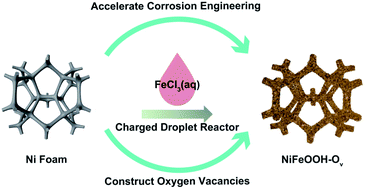Charged droplet-driven fast formation of nickel–iron (oxy)hydroxides with rich oxygen defects for boosting overall water splitting†
Abstract
NiFe (oxy)hydroxides (NiFeOOH) are considered as one of the most efficient electrocatalysts for water splitting. Although several strategies recently have been developed to fabricate NiFeOOH electrodes, such as electrodeposition, hydrothermal reaction, corrosion engineering, etc., it has been a challenge to directly tune the energy level, conductivity and surface properties (such as molecular adsorption) of NiFeOOH with less time-consuming and convenient synthesis to overcome the relatively sluggish reaction kinetics. Herein, we, for the first time, utilize charged droplets to synthesize NiFeOOH with abundant oxygen vacancies (Ov) via the convenient electrospraying (ESI) approach without necessitating additional post-treatments. Specifically, the optimized NiFeOOH delivers much lower overpotentials of 145 mV, 215 mV and 360 mV for the hydrogen evolution reaction (HER), the oxygen evolution reaction (OER) and overall water splitting in 1 M KOH at 10 mA cm−2 with long-term durability over 180 h. The good performing electrocatalyst is much improved compared with the benchmark Pt/C/NF in the high current density region, RuO2/NF and other NiFe-based electrocatalysts. Simultaneously, the unique reaction environment of the droplet (confinement, superacid and desolvation) was further explored to understand the synthesis reaction acceleration process and related oxygen defect formation mechanisms. Also, we used density functional theory (DFT) to investigate the change of free energy of the reaction pathway caused by oxygen vacancies and understand the reaction mechanism of electrocatalysts prepared by different treatment methods. The calculation results show that the shortened Fe–O bonds and oxygen defects of NiFeOOH synergistically improve the interaction between the metal cations and the intermediate species and further accelerate the overall reaction kinetics. This work demonstrates that the charged microdroplet chemistry offers a novel means to expedite the design of powerful electrocatalysts.

- This article is part of the themed collection: Journal of Materials Chemistry A Emerging Investigators


 Please wait while we load your content...
Please wait while we load your content...